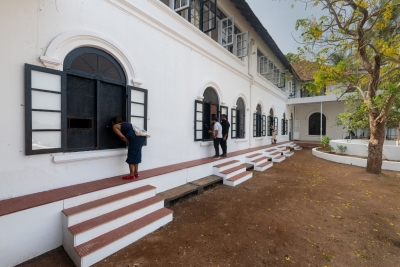Kochi: Visitors are not allowed into the Bengaluru-based Archana Hande’s installation ‘My Kottige’ – demon temple, put up for display at the Fort Kochi Aspinwall House.
The viewers are instead guided into the work of art through pipes, small doors, and windows fitted at various places on the walls of the room.
Take a look and one can see scraps, including kitchen utensils like knives and scoops and things like iron boxes and shovels, laid out aesthetically.
What inspired Hande to create an artwork from discarded materials in daily life is the wisdom she received from her grandmother that “Kalu-Kudka will save you from all harm and evil”.
Kalu-Kudka means drink-drunk ghost. This personal god, lovingly called KK by the artist, has got a temple of its own. That is a major component of the artwork by Archana.
Her work also gives a hint of an ‘evil eye’.
In South Indian architecture, there are certain modifications done to constructions to evade the spell cast by ‘evil eyes’.
Blocking vision using sheets or panels with holes in them is one such modification. Another is placing stone window frames to peep in secretly and erecting columns to hide behind.
“Through the installation ‘My Kottige’, which brings together the demon temple and the modifications to stop the evil eye, a modern demon temple meant for an urban society has been raised,” said Hande.
“The objective is the creation of a demon temple, a place of worship that protects contemporary society from the evil eyes of cast, creed, and gender disparity. The discarded old substances made of iron have been picked up from the workplaces of those involved in physical labour. They talk about supremacy and authoritarianism. Being cast out, thrown away, or discarded is contemporaneous. The fact that iron objects from bygone days are all now rusty brings out different levels of meanings,” said Hande.
–IANS


Comments are closed.